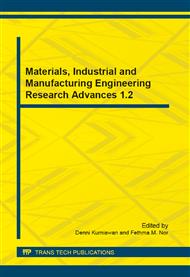[1]
T. Grant, T. Beer, P.K. Campbell, D. Batten, Life cycle assessment of environmental outcomes and greenhouse gas emissions from biofuels production in Western Australia, Department of Agriculture and Food Government of Western Australia, Western Australia, (2008).
Google Scholar
[2]
P. Mercurio, K.A. Burns, and A. Negri, Testing the ecotoxicology of vegetable versus mineral based lubricating oils: 1. Degradation rates using tropical marine microbes, Environmental Pollution, 2004. 129(2): pp.165-173.
DOI: 10.1016/j.envpol.2003.11.001
Google Scholar
[3]
W. J. Bartz, Lubricants and the environment, Tribology international, 1998. 31(1): pp.35-47.
Google Scholar
[4]
I. Golshokouh, S. Syahrullail, F.N. Ani, Investigation of palm fatty acid distillate as an alternative lubricant of petrochemical based lubricants, tested at various speeds, International Review of Mechanical Engineering, 2013. 7(1): pp.72-80.
DOI: 10.4028/www.scientific.net/amm.315.941
Google Scholar
[5]
A. Adhvaryu, G. Biresaw, B.K. Sharma, S.Z. Erhan, Friction behavior of some seed oils: biobased lubricant applications, Industrial & engineering chemistry research, 2006. 45(10): pp.3735-3740.
DOI: 10.1021/ie051259z
Google Scholar
[6]
Nik W.B.W., Maleque, M.A., Ani F.N., Masjuki, H.H., Experimental investigation on system performance using palm oil as hydraulic fluid, 2007, Industrial Lubrication and Tribology, 59, (5): pp.200-208.
DOI: 10.1108/00368790710776784
Google Scholar
[7]
I. Golshokouh, S. Syahrullail, F.N. Ani, Palm fatty acid distillate as an alternative source for hydraulic oil, Applied Mechanics and Materials, 2013. pp.941-945.
DOI: 10.4028/www.scientific.net/amm.315.941
Google Scholar
[8]
S. Randles, Environmentally considerate ester lubricants for the automotive and engineering industries, Journal of Synthetic Lubrication, 1992. 9(2): pp.145-161.
DOI: 10.1002/jsl.3000090205
Google Scholar
[9]
N. Battersby, S. Pack, and R. Watkinson, A correlation between the biodegradability of oil products in the CEC L-33-T-82 and modified Sturm tests, Chemosphere, 1992. 24(12): p.1989-(2000).
DOI: 10.1016/0045-6535(92)90247-o
Google Scholar
[10]
H. H. Masjuki, M.M.A. Haseeb, Effect of mechanical factors on tribological properties of palm oil methyl ester blended lubricant, wear, 2000. 239: pp.293-299.
DOI: 10.1016/s0043-1648(00)00319-7
Google Scholar
[11]
I. Golshokouh, M.A. Golshokouh, S. Syahrullail, F.N. Ani, Jatropha Oil as Alternative Source of Lubricant Oil, Life Sci J, 2013. 10(8s): pp.268-276.
DOI: 10.4028/www.scientific.net/amm.465-466.201
Google Scholar
[12]
I. Golshokouh, M.A. Golshokouh, S. Syahrullail, F.N. Ani, Investigation of Physical Properties for Jatropha Oil in Different Temperature as Lubricant Oil, Life Sci J, 2013. 10(8s): pp.110-119.
DOI: 10.4028/www.scientific.net/amm.465-466.201
Google Scholar
[13]
A. b. Gapor Md Top Production and utilization of palm fatty acid distillate (PFAD), Lipid Technology January, Vol. 22, No. 1, (2010).
DOI: 10.1002/lite.200900070
Google Scholar
[14]
I. Golshokouh, F.N. Ani and S. Syahrullail, Wear resistance evaluation of palm fatty acid distillate using four-ball tribotester, 2012, AIP Conference Proceedings, 1440: pp.928-935.
DOI: 10.1063/1.4704306
Google Scholar
[15]
M. Husnawan, M. Saifullah, H.H. Masjuki, Development of friction force model for mineral oil basestock containing palm olein and antiwear additive, Tribology International, 2007. 40(1): pp.74-81.
DOI: 10.1016/j.triboint.2006.02.062
Google Scholar
[16]
W. Castro, J.M. Perez, S.Z. Erhan, F. Caputo, A study of the oxidation and wear properties of vegetable oils: soybean oil without additives, Journal of the American Oil Chemists' Society, 2006. 83(1): pp.47-52.
DOI: 10.1007/s11746-006-1174-2
Google Scholar
[17]
M.H. Jones, D. Scott, Industrial tribology: the practical aspects of friction, lubrication, and wear, Vol. 8. 1983: Elsevier Science & Technology.
Google Scholar
[18]
H.H. Masjuki, M. Maleque, Investigation of the anti-wear characteristics of palm oil methyl ester using a four-ball tribometer test, Wear, 1997. 206(1-2): pp.179-186.
DOI: 10.1016/s0043-1648(96)07351-6
Google Scholar
[19]
H. Singh, I. Gulati, Tribological behaviour of base oils and their separated fractions, Wear, 1991. 147(1): pp.207-218.
DOI: 10.1016/0043-1648(91)90130-m
Google Scholar


